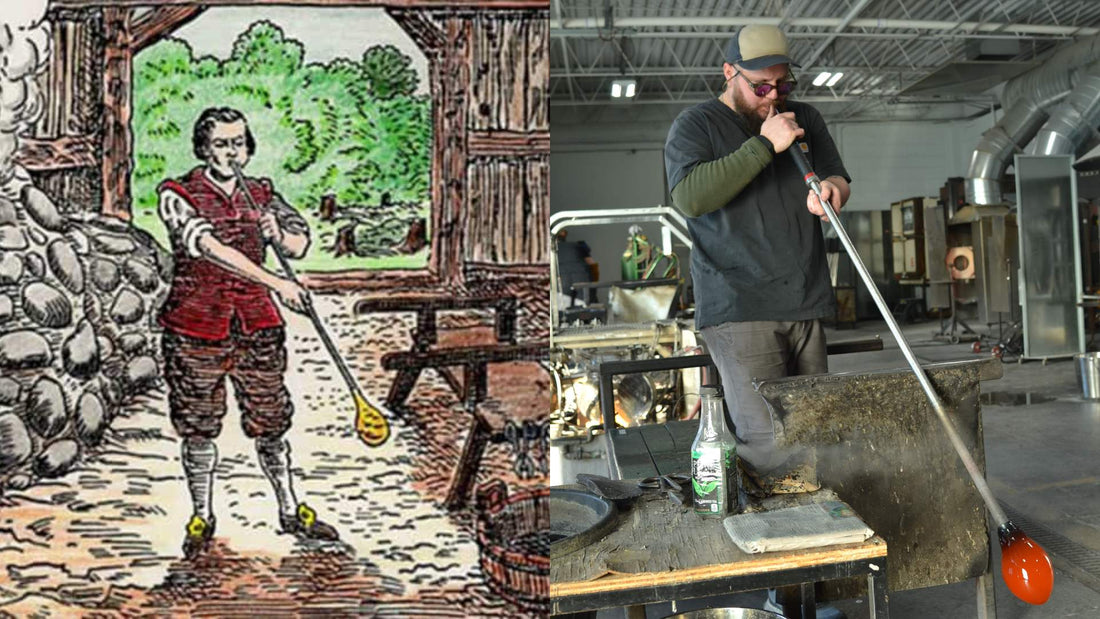
The History of Blown Glass in the United States
Ever wonder where those stunning glass pieces you see in museums, galleries, or even your own home came from? You’re in luck! Today, we’re going to explore the history of blown glass in the United States. We’ll start at the beginning and make our way to the present day, exploring how this beautiful, unique art form evolved over time.
What Is Blown Glass?
It’s helpful to understand what blown glass actually is in order to truly appreciate the history of blown glass in the United States. Think of it as a beautiful dance between an artist, fire, and molten glass. The glassblower uses a blowpipe to puff air into the molten glass, which creates a bubble. By skillfully manipulating the glass with tools and gravity, glassblowers allow a unique, intricate masterpiece to take shape.
This craft requires patience, finesse, and an understanding of the nuances of glassblowing. Over time, American artists hone their skills, producing some of the most stunning blown glass pieces that are both functional and decorative.
Colonial Beginnings: 1600s–1800s
The history of blown glass in the United States has its roots in the Colonial period, when European glassmakers brought their skills and knowledge to the American shores. Jamestown, Virginia, became home to the first glass factory in North America in 1608. Despite its early establishment, glassmaking didn’t truly flourish until the 18th century.
Throughout the 1700s and 1800s, technological advancements, an abundance of resources, and a growing demand for glass products propelled the industry forward. Iconic American glassmakers such as Henry William Stiegel, known as the “Baron of Glass,” began crafting beautiful and functional objects that would define the artistic and commercial value of American glass.
Notable glass hubs such as Sandwich, Massachusetts, and Pittsburgh, Pennsylvania, formed during this time, churning out beautiful blown glass tableware, lighting fixtures, and decorative pieces. This period saw a fusion of European techniques and American creativity, resulting in some of the most celebrated pieces of early American glass.
The Art Glass Movement: Late 1800s–Early 1900s
In the late 1800s, a new movement emerged in the world of blown glass—the art glass movement. This movement revolved around artistic expression rather than functional value, and the Art Nouveau style heavily influenced it.
Artists such as Louis Comfort Tiffany and Frederick Carder pushed the boundaries of blown glass, experimenting with new techniques and incorporating bold colors and designs. This period also saw a rise in female glass artists, such as Clara Driscoll, who were able to break into this male-dominated industry and make a name for themselves.
The art glass movement solidified America’s place as a leader in the world of blown glass, and it set the stage for future innovations and advancements in the industry.
World War II and Its Impact on Blown Glass: 1939–1945
The onset of World War II had a huge impact on the blown glass industry in the United States. Due to restrictions on resources and materials, the production of elaborate art glass pieces slowed down. Instead, factories focused on producing more functional items such as light bulbs and other necessities for the war effort.
However, the war also opened up new opportunities for glass artists across the nation and beyond. Many European glassmakers fled to America and brought their unique techniques and styles with them, further enriching the American blown glass tradition. The influences from centuries of glass work from other nations further influenced the overall design of American blown glass.
Post-World War II: Mid 1900s
After World War II, American glassmaking experienced a resurgence. Due to advancements in technology and materials, artists were able to push the boundaries further and create more innovative and intricate pieces.
Influential names such as Dale Chihuly, Harvey Littleton, and Dominick Labino emerged during this time, each bringing their own unique style to the world of blown glass.
The Studio Glass Movement: Mid-20th Century
In the 1960s, a new era of American glassmaking began with the emergence of the studio glass movement. This movement shifted focus from large factory productions to small, independent studios where artists could create one-of-a-kind pieces.
Glassblowers now had more creative freedom to explore and experiment with different techniques and styles, resulting in a diverse range of blown glass creations. For example, Chihuly’s large-scale, brightly colored glass installations and Lino Tagliapietra’s intricate Venetian-inspired pieces are just a few examples of the creativity and innovation seen during this time.
The studio glass movement also led to the establishment of glass art programs in universities and art schools, further elevating the status of blown glass in American art.
Contemporary Blown Glass: Present Day
Today, blown glass continues to thrive in the United States. There are countless individual artists and studios producing extraordinary pieces that showcase the endless possibilities of this medium. The popularity of blown glass has reached mainstream culture, with many people incorporating it into their homes as stunning decorative objects or functional pieces. For example, blown glass chandeliers have become a popular feature in modern interior design, and blown glass vases are popular tools for adding a touch of elegance to home decor.
The art of blown glass is a beautiful testament to the creativity and ingenuity of the human spirit. As you marvel at the various pieces born from this fascinating craft, don’t forget to explore modern-day blown glass creations as well. Who knows—maybe the next time you admire a piece of blown glass, you’ll have a newfound appreciation for this timeless art form and its rich history in the United States.
If you want to bring a piece of the rich history of blown glass into your own home, Bicycle Glass offers stunning blown glass lights. From pendants to sconces to chandeliers, we have a variety of designs to choose from. Our artisans create fixtures out of 100 percent recycled glass, making them beautiful and environmentally friendly. Plus, all our fixtures are highly customizable, with options for size, color, cord length, and more, so you can have a piece that truly reflects your personal style. View our collection today and explore elegant, sophisticated, blown glass designs that are sure to elevate any space.

